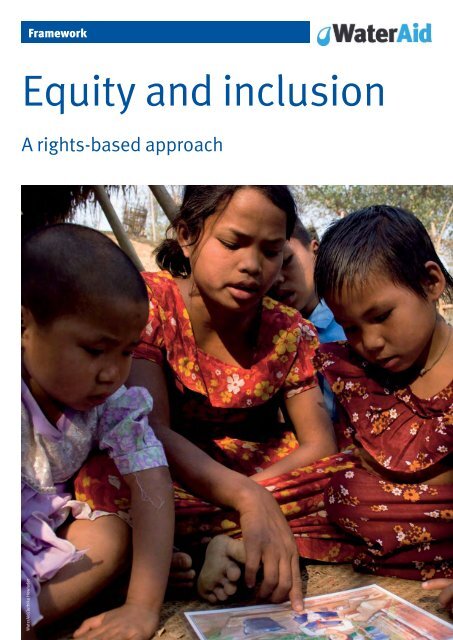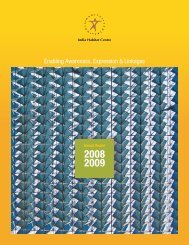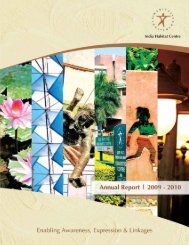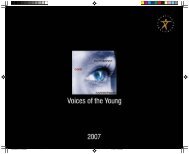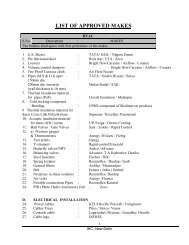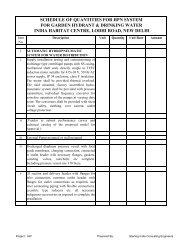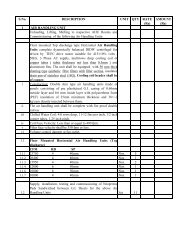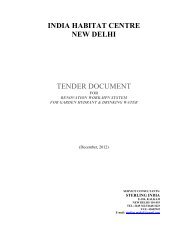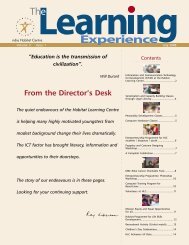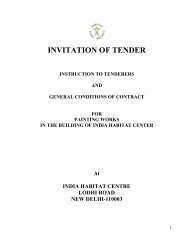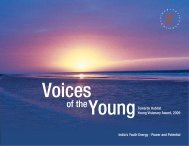Equity and inclusion A rights-based approach - India Habitat Centre
Equity and inclusion A rights-based approach - India Habitat Centre
Equity and inclusion A rights-based approach - India Habitat Centre
- No tags were found...
You also want an ePaper? Increase the reach of your titles
YUMPU automatically turns print PDFs into web optimized ePapers that Google loves.
Framework<strong>Equity</strong> <strong>and</strong> <strong>inclusion</strong>A <strong>rights</strong>-<strong>based</strong> <strong>approach</strong>WaterAid/Juthika Howlader
A WaterAid reportWritten by: Louisa GoslingWaterAid/Layton Thompson
Running headContentsForeword by Girish Menon ..............................................2Introduction <strong>and</strong> overview ..............................................4Part 1Part 2WaterAid’s position <strong>and</strong> <strong>approach</strong>..................................61 <strong>Equity</strong> <strong>and</strong> <strong>inclusion</strong> in a <strong>rights</strong>-<strong>based</strong> <strong>approach</strong> ....................62 WaterAid’s <strong>approach</strong> to equity <strong>and</strong><strong>inclusion</strong> in a <strong>rights</strong>-<strong>based</strong> <strong>approach</strong>......................................83 Implications for WaterAid –challenges in putting the framework into practice ................14St<strong>and</strong>ards <strong>and</strong> indicatorsfor equity <strong>and</strong> <strong>inclusion</strong> ..................................................171 <strong>Equity</strong> <strong>and</strong> <strong>inclusion</strong> st<strong>and</strong>ards<strong>and</strong> indicators for WaterAid ..................................................17Part 3 Explanation of terms <strong>and</strong> examples ............................231 Explanation of terms: exclusion, marginalisationvulnerability <strong>and</strong> the social model of <strong>inclusion</strong> ....................232 Examples of marginalised groups in relation to WASH..........26Acknowledgements ........................................................32<strong>Equity</strong> <strong>and</strong> <strong>inclusion</strong>. A <strong>rights</strong>-<strong>based</strong> <strong>approach</strong>1
Running headForewordOver the past few decades we have seen major strides in global development.More children go to school, child morbidity <strong>and</strong> mortality have gone down, <strong>and</strong>income levels have been raised. This progress has been brought about by acombination of political will, better resources, access to markets, technologicalinnovations <strong>and</strong> public awareness. While these improvements are impressive, theymask the pervasive inequity in development outcomes. Many people, especiallythe poorest, do not benefit from modern day progress <strong>and</strong> they are excluded fromopportunities that could take them out of poverty.Gender, caste, ethnicity, age, <strong>and</strong> disability are some of the key causes for exclusion,which then results in a downward spiral of development. Exclusion <strong>and</strong> inequitableaccess to services <strong>and</strong> opportunities – including water <strong>and</strong> sanitation – are of majorconcern for all organisations committed to human development. The World Bank’sWorld Development Report 2006, <strong>Equity</strong> <strong>and</strong> Development concludes that‘Inequality of opportunity, both within <strong>and</strong> among nations, sustains extremedeprivation, results in wasted human potential <strong>and</strong> often weakens prospectsfor overall prosperity <strong>and</strong> economic growth’.WaterAid has always been deeply committed to issues of equity. Since ourestablishment in 1981 we have chosen to work in some of the poorest countriesof the world in Africa <strong>and</strong> Asia, <strong>and</strong> within these, to work with people who aremarginalised. We have always endeavored to underst<strong>and</strong> the gender dimensionsof water <strong>and</strong> sanitation services, <strong>and</strong> are now building our underst<strong>and</strong>ing of otherissues that commonly result in exclusion, such as disability, HIV/AIDS <strong>and</strong> age.WaterAid’s Global strategy 2009-15 provides the strategic perspective to build onthis experience <strong>and</strong> integrate equity <strong>and</strong> <strong>inclusion</strong> in all aspects of our work. Ourmission is about ‘transforming lives of people’, so we need to underst<strong>and</strong> howpeople are excluded from essential services <strong>and</strong> how this affects their lives. Ourfirst aim is to ‘promote <strong>and</strong> secure poor people’s <strong>rights</strong> <strong>and</strong> access’, which meanswe must adopt a <strong>rights</strong>-<strong>based</strong> <strong>approach</strong> to issues of equity <strong>and</strong> <strong>inclusion</strong>.We now need a common, coherent <strong>and</strong> pragmatic underst<strong>and</strong>ing of equity <strong>and</strong><strong>inclusion</strong> so we can integrate it into our work <strong>and</strong> that of our partners. We also needminimum st<strong>and</strong>ards <strong>and</strong> indicators to make sure we are effective. This equity <strong>and</strong><strong>inclusion</strong> framework aims to address these needs. We have developed it by buildingon our own past experiences, <strong>and</strong> on the experience of other organisations. It wasfinalised at the international <strong>Equity</strong> <strong>and</strong> Inclusion workshop in Addis Ababa,Ethiopia, in November 2009.2 <strong>Equity</strong> <strong>and</strong> <strong>inclusion</strong>. A <strong>rights</strong>-<strong>based</strong> <strong>approach</strong>
ForewordMany people have contributed to this work. Louisa Gosling, <strong>Equity</strong> <strong>and</strong> InclusionAdviser, has patiently <strong>and</strong> with deep commitment guided its progress over thepast 18 months, through extensive consultation with WaterAid staff <strong>and</strong> externalorganisations. Lydia Zigomo, Head of East Africa region, provided the leadership,building ownership <strong>and</strong> buy-in within the organisation. Shamila Jansz, ProgrammeLearning Officer, played a key role in capturing <strong>and</strong> disseminating experience <strong>and</strong>in organising the <strong>Equity</strong> <strong>and</strong> Inclusion workshop. Mary O’Connell (Policy OfficerCapacity Building) <strong>and</strong> Adam Furse (International HR Projects Manager) have beencritically <strong>and</strong> actively involved as members of the <strong>Equity</strong> <strong>and</strong> Inclusion core group.Jerry Adams, Head of Programme Effectiveness Unit, supported Louisa in her role asAdviser. This progress could not have been achieved without the active engagement<strong>and</strong> passionate commitment of all members of the virtual <strong>Equity</strong> <strong>and</strong> Inclusionworking group, especially the focal persons in country programmes: Artur Matavele,Christiane R<strong>and</strong>rianarisoa-Rasol, Clarisse Baghnyan, Destina Samani, HerbertKashililah, Indira Khurana, Juanita During, Mahider Tesfu, Nancy Mukumbuta,Ngabaghila Chatata, Om Prasad Gautam, Pascaline Ouedraogo, Pono Fistone,Quratulain Saddiqui, Rosie Wheen, Sarah Muzaki, Shamim Ahmed, Spera Atuhairwe.The Directors Team has encouraged us over the past year to take this work forward<strong>and</strong> is fully committed to support this important area of our work.The development of this framework has been an extremely productive <strong>and</strong>collaborative process. I sincerely hope it will promote a practical underst<strong>and</strong>ing ofequity <strong>and</strong> <strong>inclusion</strong>, <strong>and</strong> will guide our implementation of the <strong>Equity</strong> <strong>and</strong> Inclusionpolicy, approved by the Directors Team in January 2010. I am confident that this willenable us to reach out to those who are excluded <strong>and</strong> marginalised, <strong>and</strong> help usrealise our mission of transforming lives by improving access to safe water, hygiene<strong>and</strong> sanitation in the world’s poorest communities.Girish MenonDirector of International Programmes12 January 2010<strong>Equity</strong> <strong>and</strong> <strong>inclusion</strong>. A <strong>rights</strong>-<strong>based</strong> <strong>approach</strong>3
Executive summaryIntroduction <strong>and</strong> overviewWaterAid believes that access to safe water, improved hygiene <strong>and</strong> sanitation(WASH) is a human right. These essential services underpin human development<strong>and</strong> transform lives, enabling people to overcome poverty. WaterAid’s entry pointis one of anti-poverty. We believe that poverty, marginalisation, <strong>and</strong> social exclusionare inextricably linked.In order to realise our vision of a world where everyone has access to safe water<strong>and</strong> sanitation, WaterAid is committed to working with its partners to reach thosewithout access to WASH. This includes the poorest <strong>and</strong> most marginalised who willremain unserved even when the MDGs are met. This means WaterAid must addressexclusion from WASH as it relates to wider inequalities in power relations <strong>and</strong> incontrol over water <strong>and</strong> other resources within the family, community <strong>and</strong> atinstitutional levels.Those who are likely to be particularly disadvantaged include women, children,people with disabilities, older people, people living with chronic illness includingHIV/AIDS, people belonging to specific castes, religions, ethnic groups, indigenousgroups, <strong>and</strong> people living in remote or peripheral areas. Other socially excludedgroups include people who are lesbian, gay, bisexual, or transgender, displacedpeople, travellers, pastoralists, illegal settlers or people working in particularoccupations, such as manual scavengers. Accordingly, WaterAid aims to highlightat every opportunity the continuing inequalities within WASH service provision<strong>and</strong> to contribute to the significant reduction of these inequalities.The frameworkThe purpose of this framework is to help implement WaterAid’s policy on equity <strong>and</strong><strong>inclusion</strong>. It aims to:Provide a common underst<strong>and</strong>ing of equity <strong>and</strong> <strong>inclusion</strong> in relation to WASHExplain WaterAid’s <strong>approach</strong> to equity <strong>and</strong> <strong>inclusion</strong>Establish a common set of minimum st<strong>and</strong>ards <strong>and</strong> indicators as a basis forfurther work in specific countries or parts of the organisation4 <strong>Equity</strong> <strong>and</strong> <strong>inclusion</strong>. A <strong>rights</strong>-<strong>based</strong> <strong>approach</strong>
Introduction <strong>and</strong> overviewThe framework has three sections:1 WaterAid’s position <strong>and</strong> <strong>approach</strong> <strong>Equity</strong> <strong>and</strong> <strong>inclusion</strong> in a <strong>rights</strong>-<strong>based</strong> <strong>approach</strong> WaterAid’s <strong>approach</strong> to equity <strong>and</strong> <strong>inclusion</strong> in a <strong>rights</strong>-<strong>based</strong> <strong>approach</strong> Implications for WaterAid – challenges in putting the framework into practice2 St<strong>and</strong>ards <strong>and</strong> indicators for equity <strong>and</strong> <strong>inclusion</strong><strong>Equity</strong> <strong>and</strong> <strong>inclusion</strong> st<strong>and</strong>ards <strong>and</strong> indicators for WaterAid3 Explanation of terms <strong>and</strong> examplesExplanation of terms: exclusion, marginalisation, vulnerability <strong>and</strong> the socialmodel of <strong>inclusion</strong>Examples of marginalised groups in relation to WASHWhile the whole organisation is working to become more equitable <strong>and</strong> inclusive,we need to recognise that there are different ways of getting there dependingon country <strong>and</strong> context, <strong>and</strong> existing levels of awareness <strong>and</strong> experience. Thisframework provides a common platform from which to develop detailed guidance<strong>and</strong> plans of action in different areas of work. It includes minimum st<strong>and</strong>ards toapply in each area, <strong>and</strong> guidance on areas to work on over time.<strong>Equity</strong> <strong>and</strong> <strong>inclusion</strong>. A <strong>rights</strong>-<strong>based</strong> <strong>approach</strong>5
Executive summaryPart 1WaterAid’s position <strong>and</strong> <strong>approach</strong>1 <strong>Equity</strong> <strong>and</strong> <strong>inclusion</strong> in a <strong>rights</strong>-<strong>based</strong> <strong>approach</strong>WaterAid has adopted equity <strong>and</strong> <strong>inclusion</strong> as core principles, intrinsic to a <strong>rights</strong><strong>based</strong><strong>approach</strong>, to ensure we address issues of marginalisation <strong>and</strong> exclusionin order to realise our vision of a world where everyone has access to safe water<strong>and</strong> sanitation.<strong>Equity</strong> is the principle of fairness<strong>Equity</strong> involves recognising that people are different <strong>and</strong> need different support<strong>and</strong> resources to ensure their <strong>rights</strong> are realised. To ensure fairness, measuresmust often be taken to compensate for specific discrimination <strong>and</strong> disadvantages.At a local level this means looking at relative disparities or disadvantages withinfamilies <strong>and</strong> communities, underst<strong>and</strong>ing exactly what barriers are faced bydisadvantaged people in accessing services, <strong>and</strong> developing ways to overcomethese barriers.At national <strong>and</strong> international level it means underst<strong>and</strong>ing the dynamics that resultin certain countries or regions being favoured over others, or certain sections of thepopulation enjoying greater political influence, <strong>and</strong> working to direct support tothose with least influence or access to services.Internally, equity means identifying <strong>and</strong> wherever possible removing the barriersthat prevent the recruitment, retention <strong>and</strong> optimal performance of the best personto do the job.Inclusion is the process of ensuring that all are able to participate fullyInclusion is a development issue. The process of <strong>inclusion</strong> is not just aboutimproving access to services, but also supporting people – including those who arediscriminated against <strong>and</strong> marginalised – to engage in wider processes to ensurethat their <strong>rights</strong> <strong>and</strong> needs are recognised. For example in planning <strong>and</strong> managingservice delivery, in decision-making, <strong>and</strong> in holding duty bearers to account throughcitizens’ action.Ultimately the groups who are marginalised need to be integrated into the politicalsystem in order to uphold their <strong>rights</strong> of access to WASH. WaterAid should supportthis process in an appropriate manner according to the country context in whichit is working.6<strong>Equity</strong> <strong>and</strong> <strong>inclusion</strong>. A <strong>rights</strong>-<strong>based</strong> <strong>approach</strong>
Part 1 – WaterAid’s position <strong>and</strong> <strong>approach</strong><strong>Equity</strong> <strong>and</strong> <strong>inclusion</strong> are therefore interrelated. In practice, addressing themrequires: better recognition <strong>and</strong> underst<strong>and</strong>ing of the differential needs ofindividuals <strong>and</strong> groups; identifying <strong>and</strong> tackling the root causes of exclusion;promoting <strong>and</strong> supporting their <strong>inclusion</strong> in decision-making processes; <strong>and</strong>identifying <strong>and</strong> implementing appropriate <strong>and</strong> sustainable solutions. This appliesboth to the programme work of WaterAid <strong>and</strong> to our internal culture <strong>and</strong> procedures.Moving from a focus on needs to a focus on <strong>rights</strong>A needs-<strong>based</strong> <strong>approach</strong> aims to change people’s situation of deprivation or lackof access to services, viewing people as passive ‘recipients’ or ‘beneficiaries’. This<strong>approach</strong> may satisfy the needs of that group of people for now but there are noguarantees that improvements in access will be sustained.A <strong>rights</strong>-<strong>based</strong> <strong>approach</strong> is a transformational development process in which peopleare the drivers <strong>and</strong> subjects of their own development. Moving to a <strong>rights</strong>-<strong>based</strong><strong>approach</strong> implies focusing on the relationship between state <strong>and</strong> civil society.A <strong>rights</strong>-<strong>based</strong> <strong>approach</strong> is about improving wider systems of governance whichdetermine progress towards our vision of a world where everyone has access tosafe water <strong>and</strong> sanitation. It implies a change in the power dynamics between thosewithout access <strong>and</strong> the duty bearers. It aims to bring about sustainable <strong>and</strong> longterm structural change in policies, procedures <strong>and</strong> laws, as well as changes inattitudes <strong>and</strong> behaviours. There are also incremental benefits in implementinga <strong>rights</strong>-<strong>based</strong> <strong>approach</strong> <strong>and</strong> considerable potential for multiplier effects byfocusing at a number of different levels. For example, ensuring that public water<strong>and</strong> sanitation budgets address the needs of disadvantaged <strong>and</strong> marginalisedgroups <strong>and</strong> ensuring that public institutions such as schools <strong>and</strong> hospitals are fullyaccessible to all.<strong>Equity</strong> <strong>and</strong> <strong>inclusion</strong>. A <strong>rights</strong>-<strong>based</strong> <strong>approach</strong> 7
Part 1 – WaterAid’s position <strong>and</strong> <strong>approach</strong>2 WaterAid’s <strong>approach</strong> to equity <strong>and</strong> <strong>inclusion</strong> ina <strong>rights</strong>-<strong>based</strong> <strong>approach</strong>WaterAid recognises the right of all to safe water, sanitation <strong>and</strong> hygiene. 1 Thisincludes those who are particularly poor <strong>and</strong> marginalised, without discrimination.Non-discrimination means avoiding discrimination against particular people <strong>and</strong>groups. It also means taking proactive measures to ensure that government policies<strong>and</strong> programmes do not exclude certain people <strong>and</strong> groups by failing to addresstheir particular needs. For example, in Malawi, Bangladesh <strong>and</strong> Tanzania WaterAid isworking with utilities in urban areas to increase their focus on pro-poor service delivery.WaterAid recognises that to contribute to the progressive realisation of these <strong>rights</strong>,we must:Underst<strong>and</strong> the reasons why people lack access to basic water <strong>and</strong> sanitation inthe 21st century (political, economic, social, cultural, etc). Water <strong>and</strong> sanitationfor all is achievable. The fact that billions of people continue to live <strong>and</strong> die inwater <strong>and</strong> sanitation poverty is a direct result of decisions taken, or not taken,by those in power. It is unnecessary <strong>and</strong> completely unacceptable.Work with duty bearers to strengthen their capacity to fulfil their obligations<strong>and</strong> to increase their accountability <strong>and</strong> responsiveness to all <strong>rights</strong> holders.For example, in East <strong>and</strong> Southern Africa WaterAid uses water point mapping toinform government planning <strong>and</strong> target investment for greater equity. Our work inWest, East <strong>and</strong> Southern Africa on localising Millennium Development Goals ishelping to build local government capacity to plan effectively.Work closely with those who do not have access to WASH to empower themto claim their <strong>rights</strong> to WASH. For example, communities <strong>and</strong> civil society useinformation from water point mapping to hold service providers to account forresource allocation through citizens’ action. 2Apply the human <strong>rights</strong> principles of participation, non-discrimination,transparency <strong>and</strong> accountability; <strong>and</strong> st<strong>and</strong>ards of adequate quantity <strong>and</strong>quality, equitable distribution, physical accessibility <strong>and</strong> economic affordability.Human <strong>rights</strong> conventions that refer to the right to water <strong>and</strong> sanitation can be usedfor advocacy initiatives, where appropriate. This includes UN conventions, as wellas regional <strong>and</strong> national agreements, on the <strong>rights</strong> of persons with disabilities, the<strong>rights</strong> of children, the <strong>rights</strong> of women, of indigenous peoples, of older people <strong>and</strong>on the elimination of racial discrimination. These can also form the basis foralliances <strong>and</strong> linkages with other sectors. Alliances with the media can help bringpublic pressure to bear on decision-makers <strong>and</strong> ensure the voices of marginalisedpeople are heard.Mainstreaming equity <strong>and</strong> <strong>inclusion</strong> is a means of recognising that <strong>rights</strong> areuniversal, <strong>and</strong> that special measures must be taken to protect, promote <strong>and</strong> fulfilthe <strong>rights</strong> of the poorest, the marginalised <strong>and</strong> those in vulnerable situations.It means ensuring that these principles <strong>and</strong> issues are incorporated in all areas1 www.righttowater.info2 WaterAid (2008) Stepping into action. The second report on Citizens’ Action for accountability in water <strong>and</strong> sanitation8<strong>Equity</strong> <strong>and</strong> <strong>inclusion</strong>. A <strong>rights</strong>-<strong>based</strong> <strong>approach</strong>
Part 1 – WaterAid’s position <strong>and</strong> <strong>approach</strong>of organisational policy, strategy <strong>and</strong> action. It will help to ensure that we recognisethe needs, priorities <strong>and</strong> capacities of different people, <strong>and</strong> that we challenge thebarriers that prevent their right to safe water <strong>and</strong> sanitation from being realised.This will be a long term process that involves building up our own <strong>and</strong> our partners’capacity to address exclusion issues in WASH programmes. We need to ensure theorganisational culture is inclusive, <strong>and</strong> develop the awareness, sensitivity <strong>and</strong> skillsof staff <strong>and</strong> partners. We can then build on our own experience <strong>and</strong> that of otherswho work with marginalised people.It will involve taking some courageous decisions, <strong>and</strong> constantly questioning how torealise our vision of a world where everyone has access to safe water <strong>and</strong> sanitation.To move along this road we need to inspire <strong>and</strong> challenge, while taking care not tocreate more resistance.Applying the <strong>approach</strong>WaterAid has to make sure that all our structures, mechanisms <strong>and</strong> <strong>approach</strong>esare designed to promote equity <strong>and</strong> <strong>inclusion</strong> in a <strong>rights</strong>-<strong>based</strong> <strong>approach</strong> in ourprogramme work, <strong>and</strong> within the organisation. At the same time, we have to buildup our expertise in the specific risks, cultural issues, <strong>approach</strong>es <strong>and</strong> adaptationsrequired to work effectively with different excluded groups.The WaterAid <strong>approach</strong> to equity <strong>and</strong> <strong>inclusion</strong> is to: Ensure that equity <strong>and</strong> <strong>inclusion</strong> is mainstreamed in its policies <strong>and</strong> procedures,including: Country sector analysis <strong>and</strong> strategic planning Programme design <strong>and</strong> implementation Monitoring, evaluation <strong>and</strong> research Training <strong>and</strong> capacity building Leadership <strong>and</strong> people management Fundraising <strong>and</strong> communications Policy advocacyDevelop guidelines <strong>and</strong> minimum st<strong>and</strong>ards that articulate the specific issuesaround WASH in relation to gender, disability, age, HIV/AIDS, <strong>and</strong> different ethnicgroups, religions, or castes.Continue, with partners, to build on <strong>and</strong> develop expertise <strong>and</strong> experience ofworking with specific excluded groups, to strengthen their capacity to dem<strong>and</strong>WASH. Also to work on the supply side with donors, national <strong>and</strong> localgovernments <strong>and</strong> service providers to be responsive to the needs <strong>and</strong> <strong>rights</strong>of these groups <strong>and</strong> to be accountable to them.Ensure that internal organisational structures <strong>and</strong> mechanisms are consistentwith this <strong>approach</strong>.<strong>Equity</strong> <strong>and</strong> <strong>inclusion</strong>. A <strong>rights</strong>-<strong>based</strong> <strong>approach</strong> 9
Part 1 – WaterAid’s position <strong>and</strong> <strong>approach</strong>Applying equity <strong>and</strong> <strong>inclusion</strong> in a <strong>rights</strong>-<strong>based</strong><strong>approach</strong> through WaterAid’s Global strategy 2009-15WaterAid’s vision is of a world where everyone has access to safe water<strong>and</strong> sanitation. This means that nobody should be excluded through discrimination or becausethey are powerless to claim their <strong>rights</strong>.WaterAid’s mission is to transform lives by improving access to safewater, hygiene <strong>and</strong> sanitation in the world’s poorest communities.We work with partners <strong>and</strong> influence decision-makers to maximiseour impact. We emphasise the linkage between inadequate WASH <strong>and</strong> poverty,marginalisation <strong>and</strong> social exclusion, how they reinforce each other, <strong>and</strong> theimportance of breaking the cycle. We recognise that we need to pay particularattention to the poorest <strong>and</strong> most marginalised people.WaterAid works with partners to influence policy <strong>and</strong> deliver safe water,improved hygiene <strong>and</strong> sanitation services that are: Appropriate: recognising the different designs <strong>and</strong> <strong>approach</strong>es needed to ensureaccess for all.Integrated: with other interventions/<strong>approach</strong>es promoting the <strong>rights</strong> <strong>and</strong>development of people who are marginalised.Sustainable: ensuring that the lasting impact is equitable.Informed: gathering evidence <strong>and</strong> building on experiences of working withmarginalised <strong>and</strong> excluded people.Transferable: to promote inclusive <strong>approach</strong>es to other agencies.10<strong>Equity</strong> <strong>and</strong> <strong>inclusion</strong>. A <strong>rights</strong>-<strong>based</strong> <strong>approach</strong>
Part 1 – WaterAid’s position <strong>and</strong> <strong>approach</strong>Global strategic aims:1 We will promote <strong>and</strong> secure poor people’s <strong>rights</strong> <strong>and</strong> access tosafe water, improved hygiene <strong>and</strong> sanitation.Work with partners to empower excluded <strong>and</strong> marginalised people to dem<strong>and</strong> their<strong>rights</strong> to safe water <strong>and</strong> sanitation <strong>and</strong> participate in decision-making about WASH.Make sure WASH programmes ensure access to safe water <strong>and</strong> sanitation forsocially excluded <strong>and</strong> marginalised people, recognising that their priorities areleast likely to be respected by those with most influence.Ensure that WASH programmes raise awareness of equity <strong>and</strong> <strong>inclusion</strong> issueswith duty bearers, partners <strong>and</strong> communities.For example:• Ensuring gender issues are addressed by providing gender awareness training incommunities, reserving places for women <strong>and</strong> members of lower castes on water <strong>and</strong>sanitation user committees, <strong>and</strong> assessing the impact of improved access to WASH onboth men <strong>and</strong> women. 3• Supporting water <strong>and</strong> sanitation NGO networks to be accountable by reporting on thecontribution of civil society to the sector, with a focus on equity <strong>and</strong> <strong>inclusion</strong>. 42 We will support governments <strong>and</strong> service providers in developingtheir capacity to deliver safe water, improved hygiene <strong>and</strong> sanitation. Promote a pro-poor focus <strong>and</strong> awareness of equity <strong>and</strong> <strong>inclusion</strong> in the policies<strong>and</strong> practice of government <strong>and</strong> service providers.Promote good governance <strong>and</strong> responsiveness to recognise the <strong>rights</strong> <strong>and</strong> meetthe needs of marginalised people <strong>and</strong> groups.Develop the skills <strong>and</strong> capacity of all involved in the sector in addressing equity<strong>and</strong> <strong>inclusion</strong>.For example:• Using research into the causes of exclusion from WASH services to highlight wherenon-discrimination at policy level is not put into practice because of a lack ofimplementation mechanisms. 5• Producing national equity reports with water <strong>and</strong> sanitation networks to share at jointsector annual reviews. These analyse the geographical equity of budget allocations<strong>and</strong> infrastructure, <strong>and</strong> the social equity of representation in decision-making. 63 WaterAid in Nepal (2009) Seen but not heard? A review of the effectiveness of gender <strong>approach</strong>es in water <strong>and</strong> sanitation service provision.www.wateraid.org/nepal4 Ug<strong>and</strong>a Water <strong>and</strong> Sanitation NGO Network (UWASNET) Secretariat (2009) NGO Group Performance in the Ug<strong>and</strong>an Water <strong>and</strong> Sanitation Sector:Report for the FY 2008/095 WaterAid in Malawi (2008) Reaching out to the excluded. Exclusion study on water, sanitation <strong>and</strong> hygiene delivery in Malawi6 WaterAid in Tanzania (2009) Out of sight <strong>and</strong> out of mind? Are marginalised communities being overlooked in decision making? Water <strong>and</strong> sanitation equity report<strong>Equity</strong> <strong>and</strong> <strong>inclusion</strong>. A <strong>rights</strong>-<strong>based</strong> <strong>approach</strong> 11
Part 1 – WaterAid’s position <strong>and</strong> <strong>approach</strong>• Supporting partners <strong>and</strong> service providers to develop inclusive water, sanitation <strong>and</strong>hygiene services for people with disabilities. 7• Supporting local government to direct resources in a more equitable <strong>and</strong> sustainablemanner through the Local Millennium Development Goal Initiative in West, East <strong>and</strong>Southern Africa. This also puts pressure on central government to release appropriateresources to local government, <strong>and</strong> enables communities to hold local government toaccount for equitable service delivery.• Influencing national governments <strong>and</strong> the Joint Monitoring Programme (JMP) todisaggregate sector monitoring data by gender, age or disability <strong>and</strong> adopt datagathering techniques to identify who is served <strong>and</strong> who is excluded from WASH.3 We will advocate for the essential role of safe water, improvedhygiene <strong>and</strong> sanitation in human development. Emphasise to other sectors the linkage between poor WASH <strong>and</strong> poverty, margin -alisation <strong>and</strong> social exclusion; how they reinforce each other <strong>and</strong> the importanceof breaking the cycle in order to enable human <strong>and</strong> economic development.Influence development actors to give appropriate priority to WASH issues witha focus on marginalised groups using evidence <strong>and</strong> practice in WASH.For example:• Influencing the education sector to recognise the importance of WASH in makingschools inclusive, by ensuring infrastructure <strong>and</strong> hygiene education address thedifferent needs of children with disabilities <strong>and</strong> of adolescent girls. 8• Working with organisations focusing on HIV/AIDS to promote WASH in anappropriate way. 9• Research <strong>and</strong> advocacy for policy change that recognises the importance of WASH inhealth <strong>and</strong> the particular vulnerability of certain groups of people to consequences ofpoor WASH <strong>and</strong> related diseases. 10• Supporting citizen monitoring by older people to promote their ability to dem<strong>and</strong>access to appropriate basic services including WASH.• Work with the media to take voices of marginalised citizens to the decision-makers <strong>and</strong>to bring pressure on them to act.17 WaterAid in Mali (2008) All people, one goal, all access. Water <strong>and</strong> sanitation access for people with disabilities18 WaterAid in Nepal (2009) Is menstrual hygiene <strong>and</strong> management an issue for adolescent school girls?A comparative study of four schools in different settings of Nepal.19 WaterAid in Tanzania <strong>and</strong> AMREF Tanzania (2009) Water <strong>and</strong> sanitation for people living with HIV <strong>and</strong> AIDS: Exploring the challenges10 WaterAid (2009) Fatal neglect. How health systems are failing to comprehensively address child mortality12<strong>Equity</strong> <strong>and</strong> <strong>inclusion</strong>. A <strong>rights</strong>-<strong>based</strong> <strong>approach</strong>
Part 1 – WaterAid’s position <strong>and</strong> <strong>approach</strong>4 We will further develop as an effective global organisationrecognised as a leader in our field <strong>and</strong> for living our values.Promote a positive <strong>and</strong> inclusive working environment that recognises <strong>and</strong>values difference <strong>and</strong> diversity as essential for delivering our mission.Develop leadership <strong>and</strong> people management to promote diversity as a guidingprinciple <strong>and</strong> promote <strong>and</strong> enforce inclusive practice.Build the capacity of the organisation <strong>and</strong> staff in the skills, behaviours <strong>and</strong>attitudes needed to respond to the most marginalised people.Continue to develop our underst<strong>and</strong>ing, gather evidence <strong>and</strong> share learning onequity <strong>and</strong> <strong>inclusion</strong> through research, monitoring, evaluation <strong>and</strong> documentation.For example:• Carrying out staff training in gender awareness in Nepal.• Ensuring wheelchair access to WaterAid’s office in Burkina Faso.• Developing diversity <strong>and</strong> difference policy <strong>and</strong> <strong>approach</strong> in Human Resources.• WaterAid in the UK has been awarded the “two ticks” certification by theDepartment for Work <strong>and</strong> Pensions, demonstrating its commitment to employingpeople with disabilities.• The leadership development programme includes diversity as a core area.Values: Inclusive, inspiring, collaborative, accountable,always learning, courageous. Inclusive as an organisation <strong>and</strong> in our work. Inspiring others to recognise <strong>and</strong> address exclusion. We will collaborate with others in order to strengthen our capacity <strong>and</strong> focus onissues of equity <strong>and</strong> <strong>inclusion</strong>. We will be accountable for ensuring our work is equitable <strong>and</strong> inclusive. Always learning from internal <strong>and</strong> external experience of work with marginalisedgroups about the issues <strong>and</strong> how to better address them. Courageous to challenge discrimination where it deprives poor people of their<strong>rights</strong> to water <strong>and</strong> sanitation.See section 2 for a set of st<strong>and</strong>ards <strong>and</strong> indicators for equity <strong>and</strong> <strong>inclusion</strong>.<strong>Equity</strong> <strong>and</strong> <strong>inclusion</strong>. A <strong>rights</strong>-<strong>based</strong> <strong>approach</strong> 13
Part 1 – WaterAid’s position <strong>and</strong> <strong>approach</strong>3 Implications for WaterAid –challenges in putting the framework into practiceWaterAid programmes have to make strategic choices about the extent to which theyshould focus on marginalised groups, which groups to focus on, with which partners,<strong>and</strong> at what cost. They will also have to make strategic choices as to the right balanceof work that should focus on influencing the capacities of duty bearers. This commit -ment by WaterAid represents an underst<strong>and</strong>ing that long term change will beincremental <strong>and</strong> will take time to effect. Some of the implications are outlined below:Proportion of work to focus on marginalised groupsAll WaterAid programmes focus on poor countries <strong>and</strong> communities with limitedaccess to WASH. Ideally they should all be broadly inclusive <strong>and</strong> address thedifferent needs of women, children, older people <strong>and</strong> disabled people within thepopulations they work with. Some work will also focus on <strong>approach</strong>es designedto reach specific marginalised groups.While some programmes have extensive experience in working with marginalised<strong>and</strong> excluded people <strong>and</strong> groups, for others it is a relatively new area. Therefore,it is up to the country programmes to take a strategic <strong>and</strong> realistic decision abouthow to extend their work to focus on different specific groups. For example,WaterAid in Nepal started with a focus on gender <strong>and</strong> poverty <strong>and</strong> then usedthe developing capacity to develop a broader ‘social <strong>inclusion</strong>’ <strong>approach</strong>.Decisions about which areas to focus on in particular may be <strong>based</strong> on: A <strong>rights</strong>-<strong>based</strong> analysis at the strategic planning stage to identify what <strong>and</strong>whose <strong>rights</strong> have not been met, why their <strong>rights</strong> are not realised (who bearsresponsibility, <strong>and</strong> constraints <strong>and</strong> obstacles to meeting responsibilities) <strong>and</strong>how best to change – how should WaterAid work <strong>and</strong> with whom. This will helpdecide on the balance between working directly with marginalised <strong>and</strong> excludedgroups in order to build their capacity to hold the duty bearers to account,<strong>and</strong>/or to work on influencing the capacity of duty bearers to be accountable<strong>and</strong> responsive to the needs <strong>and</strong> dem<strong>and</strong>s of the excluded groups.Opportunities to build on existing work, <strong>and</strong> on the expertise of existing <strong>and</strong>potential partners to work with specific groups.While taking an overall <strong>approach</strong> of mainstreaming equity <strong>and</strong> <strong>inclusion</strong> <strong>and</strong><strong>rights</strong>, whether there is merit in certain situations to also adopt a targeted<strong>approach</strong> as in poverty pocket mapping work or explicitly working with particularmarginalised groups who are especially stigmatised in particular contexts.Developing an underst<strong>and</strong>ing of <strong>rights</strong>-<strong>based</strong> <strong>approach</strong>esWe need to develop our underst<strong>and</strong>ing <strong>and</strong> further articulation of the <strong>rights</strong> to water<strong>and</strong> to sanitation, <strong>and</strong> our <strong>approach</strong>es to pro-poor policy making <strong>and</strong> reform in WASHfor urban <strong>and</strong> rural poor people.14<strong>Equity</strong> <strong>and</strong> <strong>inclusion</strong>. A <strong>rights</strong>-<strong>based</strong> <strong>approach</strong>
Part 1 – WaterAid’s position <strong>and</strong> <strong>approach</strong>Appropriate use of explicit <strong>rights</strong>-<strong>based</strong> languageThere are some contexts where it is not appropriate to explicitly use the languageof <strong>rights</strong> <strong>and</strong> <strong>rights</strong>-<strong>based</strong> <strong>approach</strong>es. For example, in certain fragile states, postconflictsituations, or countries where <strong>rights</strong> are not respected by the state, it maybe counterproductive to overtly call for <strong>rights</strong> to water <strong>and</strong> sanitation to be realised.In these circumstances, it may still be possible to use <strong>rights</strong>-<strong>based</strong> <strong>approach</strong>es,by adopting the language of equity <strong>and</strong> <strong>inclusion</strong> more directly in the way thatWaterAid has articulated in this framework, to achieve the same results.Choosing partnerships: influencing others, learning from others,influencing with othersWaterAid needs to develop the capacity of existing partners to become more inclusive<strong>and</strong> to learn from those partners that already have expertise in working with margin -alised groups <strong>and</strong> where appropriate to develop partnerships with new organisations.WaterAid needs to collaborate more closely with other organisations that are ableto promote the ability of marginalised groups to claim their right to safe water<strong>and</strong> sanitation. This could be at local, national, regional or global level. Work orcollaboration with the media which is happening in all regions of WaterAid is alsoa critical contribution in this regard.Balancing the need to be cost effective with additional costs of workingwith marginalised peopleImplementation of this framework need not incur significant additional costs. Theadditional cost of accessible facilities is minimal if planned from the outset, 11 <strong>and</strong> faroutweighed by the benefits of <strong>inclusion</strong>.Many of the additional costs are small, <strong>and</strong> some are larger. Examples of costsinclude: making WaterAid offices are physically accessible, adding support costs forpeople with special needs to meeting <strong>and</strong> training budgets, capacity building for allstaff in equity <strong>and</strong> <strong>inclusion</strong>, increased operating costs in remote or hard to reachareas as well as increased time taken for meetings <strong>and</strong> research. Developingsustainability options in marginalised communities is also more challenging.The overall cost per person of focusing on marginalised groups could be higher thanthe cost of reaching the most easily accessible people <strong>and</strong> this should be factoredinto our programming work. We can demonstrate innovative <strong>approach</strong>es toextending access to marginalised groups but our long term goal should be toinfluence government <strong>and</strong> donor policies <strong>and</strong> practice to ensure progressiverealisation of the water <strong>and</strong> sanitation <strong>rights</strong> of marginalised groups.11 Steinfeld, E. (2005) Education for All: the Cost of Accessibility. The World Bank Education Notes.<strong>Equity</strong> <strong>and</strong> <strong>inclusion</strong>. A <strong>rights</strong>-<strong>based</strong> <strong>approach</strong> 15
Part 1 – WaterAid’s position <strong>and</strong> <strong>approach</strong>Don’t let targets steer WaterAid away from equity <strong>and</strong> <strong>inclusion</strong>WaterAid’s ambitious target of reaching 25 million of the poorest <strong>and</strong> the very poorby 2015 could encourage a focus on the easier to reach <strong>and</strong> more densely populatedareas. Vigilance is needed to keep attention focused on the poorest <strong>and</strong> marginalisedwho are often hard to reach <strong>and</strong> live in less densely populated areas. The sameprinciple applies to the selection of new countries.Resources <strong>and</strong> structureWaterAid must find the best way to resource equity <strong>and</strong> <strong>inclusion</strong> in each part ofthe organisation. Time <strong>and</strong> leadership are needed. Different WaterAid offices havetaken different <strong>approach</strong>es. In Bangladesh for example, a sub-programme focusesspecifically on equity <strong>and</strong> <strong>inclusion</strong>. In other countries, the role of equity <strong>and</strong><strong>inclusion</strong> champion or focal point is added to other responsibilities. This areaneeds to be developed.Monitoring <strong>and</strong> evaluationMonitoring <strong>and</strong> evaluation systems should have the sophistication at project levelto disaggregate data by gender, age, poverty <strong>and</strong> major impairment, <strong>and</strong> at nationalor sub-national level by marginalisation, poverty <strong>and</strong> location. While this informationis not always part of WASH sector monitoring <strong>and</strong> evaluation systems it is oftenavailable in other sectors <strong>and</strong> can be adapted <strong>and</strong> integrated. Looking back studiesshould focus more on helping WaterAid to underst<strong>and</strong> who is benefiting <strong>and</strong> whois losing out at the micro level in our intervention areas so as to inform our<strong>approach</strong>es. This will provide evidence to influence others to develop equitable<strong>and</strong> inclusive <strong>approach</strong>es.Communications for equity, <strong>inclusion</strong> <strong>and</strong> <strong>rights</strong>All WaterAid communications <strong>and</strong> marketing, including terminology, films, photos<strong>and</strong> publications, should ensure that peoples’ <strong>rights</strong> are respected <strong>and</strong> thatstereotypes are not reinforced. For example people living with HIV/AIDS may notwish their face or name to be published, photographic captions should explain issuesof discrimination <strong>and</strong> exclusion from WASH, <strong>and</strong> where possible communicationsshould ensure the voices of people who are marginalised are heard.16<strong>Equity</strong> <strong>and</strong> <strong>inclusion</strong>. A <strong>rights</strong>-<strong>based</strong> <strong>approach</strong>
Part 1 – WaterAid’s position <strong>and</strong> <strong>approach</strong>Part 2St<strong>and</strong>ards <strong>and</strong> indicatorsfor equity <strong>and</strong> <strong>inclusion</strong>1 <strong>Equity</strong> <strong>and</strong> <strong>inclusion</strong> st<strong>and</strong>ards <strong>and</strong> indicators for WaterAidWaterAid is committed to applying the following st<strong>and</strong>ards to its work, withindicators that describe what the organisation should look like when equity <strong>and</strong><strong>inclusion</strong> are mainstreamed. These can be used to assess progress in mainstreamingequity <strong>and</strong> <strong>inclusion</strong>.The st<strong>and</strong>ards <strong>and</strong> indicators are organised here by strategic Aim for ease of use forplanning <strong>and</strong> review purposes, but some of them can also be seen as cross-cuttingindicators. For example st<strong>and</strong>ard 5 on monitoring <strong>and</strong> evaluation applies across allthe strategic aims.St<strong>and</strong>ards for strategic Aim 11 <strong>Equity</strong>, <strong>inclusion</strong> <strong>and</strong> <strong>rights</strong> are understood <strong>and</strong> applied by everyone in WaterAid.St<strong>and</strong>ards <strong>and</strong> guidelines are communicated to all staff <strong>and</strong> partners in anaccessible format. The framework for equity <strong>and</strong> <strong>inclusion</strong> in a <strong>rights</strong>-<strong>based</strong> <strong>approach</strong> isunderstood by everyone in WaterAid, is communicated to partners in anaccessible way <strong>and</strong> translated into WaterAid’s official languages. Guiding principles for inclusive development are developed <strong>and</strong> applied inprogramme implementation. Tools <strong>and</strong> guidelines to ensure inclusive design of facilities <strong>and</strong> <strong>approach</strong>esare available <strong>and</strong> used. Collaborative knowledge-sharing partnerships with organisations specialisingin issues of exclusion are used to increase underst<strong>and</strong>ing.2 Active <strong>and</strong> continuous enquiry into who is excluded from WASH, the causesof exclusion/discrimination (eg political, economic, social, cultural) <strong>and</strong> theimpact of exclusion on their lives <strong>and</strong> livelihoods. All country programmes actively seek to underst<strong>and</strong> who is excluded <strong>and</strong> themultiple causes of exclusion from WASH in countries where WaterAid works. Baseline monitoring <strong>and</strong> evaluation of country programme work seeksevidence of the impact of access to WASH on marginalised people.<strong>Equity</strong> <strong>and</strong> <strong>inclusion</strong>. A <strong>rights</strong>-<strong>based</strong> <strong>approach</strong> 17
Part 2 – St<strong>and</strong>ards <strong>and</strong> indicators for equity <strong>and</strong> <strong>inclusion</strong>3 Involvement of those marginalised <strong>and</strong> excluded people is always activelysought in WaterAid <strong>and</strong> partners’ programme design, plans, budget,implementation <strong>and</strong> monitoring. Views of disabled <strong>and</strong> older people, women, children, <strong>and</strong> other marginalisedgroups are always actively sought in planning community programmes (forexample, by asking pertinent questions or seeking out older <strong>and</strong> disabledpeople who may be hidden away). Women, children, people with disabilities <strong>and</strong> older people are involved in thedesign <strong>and</strong> adaptation of WASH technology intended for their use. WaterAid is seen to be a participatory <strong>and</strong> accessible organisation to membersof disadvantaged <strong>and</strong> marginalised groups. Budget provision is included in meeting <strong>and</strong> training budgets to cover supportcosts <strong>and</strong> assistance for participants with special needs. All work on tariffs <strong>and</strong> subsidies is assessed in relation to the impact on accessto WASH for the poorest <strong>and</strong> most marginalised in the communities.4 Our ability to diversify our <strong>approach</strong>es to meet different needs is demonstrated. All WASH facilities for public access (including school sanitation) areaccessible to people with disabilities, older people, have separate facilites formen <strong>and</strong> women <strong>and</strong> include appropriate facilities for menstrual hygienemanagement. Hygiene communication materials are inclusive <strong>and</strong> disseminated througha variety of means to be accessible to all. Budgets include provision for equity <strong>and</strong> <strong>inclusion</strong> aspects. Expertise <strong>and</strong> guidelines on inclusive design for water, sanitation <strong>and</strong> hygienefacilities are routinely used by WaterAid staff <strong>and</strong> partners. Programmes that focus on specific types of exclusion are developed toincrease awareness <strong>and</strong> capacity within WaterAid <strong>and</strong> for partners.5 Knowledge <strong>and</strong> evidence on equity <strong>and</strong> <strong>inclusion</strong> in WASH is gathered <strong>and</strong>disseminated through research, monitoring, evaluation <strong>and</strong> documentation. All WaterAid country programmes review monitoring <strong>and</strong> evaluationframeworks to ensure an equity <strong>and</strong> <strong>inclusion</strong> perspective. WaterAid reporting mechanisms include equity <strong>and</strong> <strong>inclusion</strong> indicators. All baseline information <strong>and</strong> monitoring <strong>and</strong> evaluation activities specificallyseek information about the impact of programmes on vulnerable <strong>and</strong> excludedgroups <strong>and</strong> data is disaggregated.18<strong>Equity</strong> <strong>and</strong> <strong>inclusion</strong>. A <strong>rights</strong>-<strong>based</strong> <strong>approach</strong>
Part 2 – St<strong>and</strong>ards <strong>and</strong> indicators for equity <strong>and</strong> <strong>inclusion</strong>St<strong>and</strong>ards for strategic Aim 216 WaterAid’s country strategic plans address the analysis of poverty,vulnerability <strong>and</strong> exclusion from WASH in deciding where <strong>and</strong> how to workrecognising exclusion at different levels: geographical, specific social <strong>and</strong>economic groups, individuals within communities <strong>and</strong> households. Sector analysis includes analysis of exclusion from WASH looking at sectoractors’ capacity, legislative blockages, resources <strong>and</strong> attitudes. Strategies are <strong>based</strong> on underst<strong>and</strong>ing of how different communities alreadyaddress equity <strong>and</strong> <strong>inclusion</strong> in WASH access.17 Awareness <strong>and</strong> focus on equitable <strong>and</strong> inclusive WASH is raised throughWaterAid’s relationships with international agencies, donors, nationalgovernments, alliances <strong>and</strong> networks. WaterAid champions the importance of inclusive WASH in all sector fora. WaterAid is recognised <strong>and</strong> valued globally <strong>and</strong> nationally for its contributionto promoting the <strong>rights</strong> of excluded <strong>and</strong> vulnerable groups to WASH.18 WaterAid influences sector actors’ capacities to be more responsive <strong>and</strong>accountable to the needs <strong>and</strong> <strong>rights</strong> of the poor who are marginalised <strong>and</strong>excluded from services. Regular discussions <strong>and</strong> sessions on equity <strong>and</strong> <strong>inclusion</strong> are held in countryprogrammes <strong>and</strong> with other stakeholders that work in the WASH sector. Inclusion is promoted <strong>and</strong> issues relevant to HIV, disability, gender <strong>and</strong> ageare incorporated in WASH sector capacity building activities.19 WaterAid influences sector performance monitoring <strong>and</strong> reporting policies<strong>and</strong> practices to incorporate equity <strong>and</strong> <strong>inclusion</strong>. Poverty <strong>and</strong> vulnerability mapping provides relevant statistics to informstrategy, policy <strong>and</strong> advocacy to increase equity <strong>and</strong> <strong>inclusion</strong>.St<strong>and</strong>ards for strategic Aim 310 WaterAid influences development actors using evidence-<strong>based</strong> research <strong>and</strong>evaluations of how exclusion from WASH impacts on development outcomes. Evidence-<strong>based</strong> research on exclusion <strong>and</strong> issue papers are widelydisseminated amongst development actors to share <strong>and</strong> promotelessons learned.11 WaterAid engages in partnerships <strong>and</strong> networks to share with, learn from,<strong>and</strong> influence other development actors to promote equity <strong>and</strong> <strong>inclusion</strong> inaccess to WASH. WaterAid actively seeks out <strong>and</strong> learns from the experience of otherorganisations (including disabled peoples organisations, civil societyorganisations, networks, alliances, donor groups <strong>and</strong> non governmentalorganisations) representing or working with marginalised <strong>and</strong> excludedpeople <strong>and</strong> groups at country regional <strong>and</strong> global level.<strong>Equity</strong> <strong>and</strong> <strong>inclusion</strong>. A <strong>rights</strong>-<strong>based</strong> <strong>approach</strong> 19
Part 2 – St<strong>and</strong>ards <strong>and</strong> indicators for equity <strong>and</strong> <strong>inclusion</strong> Alliances on securing WASH are secured with partners who promote the <strong>rights</strong>of people from excluded groups, selecting partnerships strategically tomaximise effective WASH inputs. Regular discussions <strong>and</strong> sessions on equity <strong>and</strong> <strong>inclusion</strong> in WASH are held incountry programmes <strong>and</strong> with other stakeholders that work specifically withmarginalised people <strong>and</strong> groups. WaterAid develops common hygiene messages that are used in WASH <strong>and</strong>HIV programmes.12 All WaterAid work demonstrates how integration of WASH in other sectorscontributes to more equitable <strong>and</strong> inclusive development processes <strong>and</strong> outcomes. Analysis of blockages or gaps in how WASH is addressed in other sectors,such as HIV <strong>and</strong> disability, is included in the strategy development process All public policy work <strong>and</strong> campaigning addresses equity <strong>and</strong> <strong>inclusion</strong> asappropriate <strong>and</strong> relevant to the country context. All relevant UN conventions on <strong>rights</strong> of members of marginalised groups arerespected in all our work <strong>and</strong> used where relevant in advocacy for WASH. All work on school WASH promotes <strong>inclusion</strong> as an essential requirement forhuman development.St<strong>and</strong>ards for strategic Aim 413 WaterAid produces global <strong>and</strong> national organisational policies on diversityincluding gender, disability, HIV/AIDS, sexuality, child protection <strong>and</strong> otheraspects of vulnerability, exclusion <strong>and</strong> discrimination, where appropriate. There is positive progress in developing WaterAid’s <strong>approach</strong> to diversity. All staff have access to organisational policies to secure <strong>inclusion</strong> on gender,disability, age, HIV/AIDS, sexuality, child protection <strong>and</strong> other areaswhere needed.14 <strong>Equity</strong> <strong>and</strong> <strong>inclusion</strong> is understood by all WaterAid staff <strong>and</strong> included in alltraining <strong>and</strong> inductions, taking care that it is addressed in a pragmatic <strong>and</strong>realistic way relevant to the focus of the training. <strong>Equity</strong> <strong>and</strong> <strong>inclusion</strong> is addressed in all leadership <strong>and</strong> management training<strong>and</strong> inductions. Specific training on aspects of equity <strong>and</strong> <strong>inclusion</strong> is provided where required. Some training for all staff in disability, age <strong>and</strong> gender awareness is m<strong>and</strong>atory. Staff are sensitive <strong>and</strong> confident in working with people from marginalisedgroups.20 <strong>Equity</strong> <strong>and</strong> <strong>inclusion</strong>. A <strong>rights</strong>-<strong>based</strong> <strong>approach</strong>
Part 2 – St<strong>and</strong>ards <strong>and</strong> indicators for equity <strong>and</strong> <strong>inclusion</strong>15 The workforce demographics are analysed <strong>and</strong> used to inform recruitmentpolicies <strong>and</strong> processes. Unjustifiable barriers to employment are identified<strong>and</strong> removed. Commitment to equity, <strong>inclusion</strong> <strong>and</strong> <strong>rights</strong> is demonstrated inrecruitment <strong>and</strong> induction of new staff. Each country has an analysis of its workforce composition according to metricsof gender, age, disability <strong>and</strong> other diversity metrics relevant to the country(for example including ethnic, religious or caste minorities). Each country has a plan to address unjustifiable under-representation, <strong>and</strong>to report on these. Recruitment processes are inclusive. Job descriptions all have a reference to equity <strong>and</strong> <strong>inclusion</strong>. The employment of people with disabilities is promoted across all levelsof the organisation. WaterAid is seen to be an inclusive <strong>and</strong> accessible employer by membersof disadvantaged <strong>and</strong> marginalised groups.16 WaterAid’s guidelines on accessibility <strong>and</strong> representation of excluded <strong>and</strong>marginalised people are applied to all internal <strong>and</strong> external communicationschannels <strong>and</strong> products. All messages, film <strong>and</strong> photographs displayed in all internal <strong>and</strong> externalcommunications, fundraising <strong>and</strong> all research <strong>and</strong> policy documentsthroughout the organisation that present a view of WaterAid’s work withmarginalised people do so in a way that is consistent with <strong>rights</strong>-<strong>based</strong><strong>approach</strong>es. All communications conform to highest st<strong>and</strong>ards of accessibility(using WaterAid’s Accessibility guidelines). The experience <strong>and</strong> voice of individuals from marginalised groups are clearlyrepresented in external communications including fundraising materials,media stories etc. Ethical st<strong>and</strong>ards on consent <strong>and</strong> privacy are always applied when taking <strong>and</strong>using photographs <strong>and</strong> case studies of people from marginalised groups.17 Leadership behaviours, person <strong>and</strong> job specifications, performancemanagement <strong>and</strong> personal development plans reflect a commitment<strong>and</strong> accountability to equity <strong>and</strong> <strong>inclusion</strong>. Policies <strong>and</strong> practices are in place <strong>and</strong> implemented to support diversity<strong>and</strong> underrepresented groups in the workforce. Performance management objectives include equity <strong>and</strong> <strong>inclusion</strong>. There is no significant difference in employee satisfaction by genderor disability.<strong>Equity</strong> <strong>and</strong> <strong>inclusion</strong>. A <strong>rights</strong>-<strong>based</strong> <strong>approach</strong>21
Part 2 – St<strong>and</strong>ards <strong>and</strong> indicators for equity <strong>and</strong> <strong>inclusion</strong>18 Learning about equity <strong>and</strong> <strong>inclusion</strong> is actively disseminated throughoutWaterAid <strong>and</strong> to partners. All relevant research <strong>and</strong> programme evaluations are entered <strong>and</strong> indexedon KnowledgeNet (WaterAid’s database of completed reports, research,evaluations <strong>and</strong> discussion papers) so that they are easily accessible. The Source is used to share <strong>and</strong> promote lessons learned on equity<strong>and</strong> <strong>inclusion</strong>. Examples of good practice are made available to the public on theWaterAid website.19 Accessibility audits for offices are carried out. Accessibility audits are carried out for all offices by local disabilityorganisations where possible. Offices are accessible according to organisationally agreed st<strong>and</strong>ards.22 <strong>Equity</strong> <strong>and</strong> <strong>inclusion</strong>. A <strong>rights</strong>-<strong>based</strong> <strong>approach</strong>
Part 2 – St<strong>and</strong>ards <strong>and</strong> indicators for equity <strong>and</strong> <strong>inclusion</strong>Part 3Explanation of terms <strong>and</strong> examples1 Explanation of terms: exclusion, marginalisationvulnerability <strong>and</strong> the social model of <strong>inclusion</strong>WaterAid is striving to eliminate poverty by increasing access to WASH, realising thatthe world we live in is not equitable at any level. Power, resources <strong>and</strong> opportunitiesare not distributed equally within any group of people. So it is not enough to target‘poor countries’, poor regions, poor communities, or even poor households. Weneed to look more closely at each level – who is excluded from water, sanitation <strong>and</strong>hygiene, where does this happen <strong>and</strong> why? What are all the different needs <strong>and</strong>priorities in relation to WASH, <strong>and</strong> how can these be reflected in WaterAid’sprogrammes now <strong>and</strong> in the future?The purpose of this section of the framework is to underst<strong>and</strong> what we mean whenwe refer to people who are marginalised, in vulnerable situations, <strong>and</strong> excludedfrom WASH.Exclusion <strong>and</strong> marginalisationSome people are excluded from WASH because there are no services in thecommunity, region or village in which they live. Some people are excluded fromWASH because they are not able to access services even where they do exist.Marginalisation is the social process of being confined to a lower social st<strong>and</strong>ingor to the outer limit – the margins – of society. Marginalised individuals often suffermaterial deprivation, <strong>and</strong> are excluded from information, services, programmes,<strong>and</strong> policies. People who are marginalised are often not consulted, they have littleinfluence over decisions that affect them, their voices are not heard <strong>and</strong> it is moredifficult for them to claim their <strong>rights</strong>.People are marginalised <strong>and</strong> excluded from WASH as a result of social, economic,political, geographical <strong>and</strong>/or environmental factors. These factors influence thelives of people very differently.Social factors are often deep-rooted <strong>and</strong> have been perpetuated over centuries ofsocio-cultural norms, practices <strong>and</strong> traditions. For example, the deeply held beliefthat results in menstruating women being excluded from religious <strong>and</strong> socialactivities in many societies, the belief that epilepsy is contagious, or the traditionthat fetching water is a woman’s responsibility or that older women in poorcommunities are ‘witches’. These factors can be changed by working with men,<strong>Equity</strong> <strong>and</strong> <strong>inclusion</strong>. A <strong>rights</strong>-<strong>based</strong> <strong>approach</strong>23
Part 3 – Explanation of terms <strong>and</strong> exampleswomen <strong>and</strong> children to address behaviour, attitudes <strong>and</strong> beliefs. New technologiescan also influence social roles, for example in Zambia introducing jerry cansencouraged men to carry water. 12Economic <strong>and</strong> political factors can change more quickly <strong>and</strong> their influence onpeople can vary. For instance, a change in government could result in discriminationagainst some people <strong>and</strong> exclusion from WASH whilst relatively improving theconditions of others. These factors are more likely to be addressed through policy<strong>and</strong> advocacy work – persuading duty bearers to meet their obligations <strong>and</strong>empowering marginalised people to dem<strong>and</strong> their legitimate <strong>rights</strong>.Physical <strong>and</strong> geographical factors can present huge barriers, resulting in theexclusion of populations in remote areas, individuals with mobility problems,or pastoralists. These factors often require a more technical <strong>approach</strong>, carefullytailored to the specific context <strong>and</strong> requirements.Exclusion can sometimes be unintended <strong>and</strong> indirect. The more powerful <strong>and</strong>assertive members of society are often unaware of the needs <strong>and</strong> skills of the lesspowerful. For example, if there is no conscious effort to include disabled people <strong>and</strong>their families in decision-making for WASH programmes, then their concerns mayremain hidden. As another example the WASH related labour carried out by womenis usually unpaid, <strong>and</strong> so it is valued less highly than the paid work of men <strong>and</strong> maybe less recognised by communities.There are also clear cases where exclusion is deliberate, direct <strong>and</strong> explicit, wherethose in control of WASH consciously deny access to others.Whatever the cause of exclusion the result is the same: some people’s <strong>rights</strong> toWASH are denied. People who are marginalised in society <strong>and</strong> excluded from WASHrequire specific attention to ensure that their voices are heard <strong>and</strong> their <strong>rights</strong> arenot denied.Addressing discrimination <strong>and</strong> exclusion requires developing the awareness <strong>and</strong>skills of staff <strong>and</strong> partners to question their own prejudices <strong>and</strong> to recognisediscrimination in the context of their work. It requires support for disadvantagedgroups to become more assertive to dem<strong>and</strong> their <strong>rights</strong>, <strong>and</strong> for policy <strong>and</strong>advocacy work to address institutionalised discrimination resulting in exclusion.Exclusion is about power. Most exclusion is related to power dynamics at differentlevels within the society, family, community <strong>and</strong> institutional structures where wework. We should also be aware of the power relationship between WaterAid <strong>and</strong> itspartners <strong>and</strong> with other stakeholders such as communities <strong>and</strong> government. Thesecan all affect our ability to address inequality <strong>and</strong> exclusion in our projects.12 Sally Sutton (2001) Zambia WEDC Conference paper, http://wedc.lboro.ac.uk/conferences/pdfs/27/Sutton.pdf24 <strong>Equity</strong> <strong>and</strong> <strong>inclusion</strong>. A <strong>rights</strong>-<strong>based</strong> <strong>approach</strong>
Part 3 – Explanation of terms <strong>and</strong> examplesVulnerability <strong>and</strong> povertyPeople in vulnerable situations are those who are most at risk because they havevery little capacity to cope with external threats.This makes them particularly susceptible to the negative consequences of poorWASH, including WASH related disease, <strong>and</strong> so they require special attention inWASH programmes. People in vulnerable situations include those who are veryyoung or old, living with chronic illness or living with disabilities, <strong>and</strong> other sociallyexcluded people.Poverty, exclusion <strong>and</strong> vulnerability are inextricably linked. People living in chronicpoverty often lack access to safe water, sanitation, hygiene, education, health <strong>and</strong>social services, <strong>and</strong> live in areas prone to environmental degradation. All thesefactors contribute to making people more vulnerable to the consequences of poorWASH, <strong>and</strong> these in turn push people into greater poverty. Global challenges such asurbanisation, climate change <strong>and</strong> population growth often have the greatest impacton those who are already in vulnerable situations.Social model of exclusion/<strong>inclusion</strong>The ‘social model’ focuses the elimination of barriers that prevent the effectiveparticipation of marginalised people in society. The model was developed by thedisability movement but can be applied to other people <strong>and</strong> groups facing exclusionfrom WASH. The model identifies three major barriers to <strong>inclusion</strong>:Attitudinal (negative views of people by others in society).This includes prejudice, pity, isolation, overprotection, stigma, misinformation<strong>and</strong> shame of family.Environmental (physical, accessibility of infrastructure <strong>and</strong> facilities,communication issues.) This includes barriers in the natural environment suchas rough paths, long distances, steep river banks, <strong>and</strong> muddy springs. Barriersin the built environment include steps, narrow entrances, slippery floors, highconcrete platforms, <strong>and</strong> visual hygiene education messages that are inaccessibleto people with impaired vision.Institutional/organisational (systematic exclusion or neglect in social, legal,educational, religious, political <strong>and</strong> development institutions <strong>and</strong> organisationsincluding WaterAid <strong>and</strong> its partners). These barriers include lack of policies <strong>and</strong>strategies, knowledge, skills, information, <strong>and</strong> consultation mechanisms.Everyone involved in providing WASH has a role in reducing all these barriers for allthose who are excluded.<strong>Equity</strong> <strong>and</strong> <strong>inclusion</strong>. A <strong>rights</strong>-<strong>based</strong> <strong>approach</strong>25
Part 3 – Explanation of terms <strong>and</strong> examples2 Examples of marginalised groups in relation to WASHEveryone has an identity made up of different factors: sex, age, disability, ethnicity,language, religion, <strong>and</strong> so on. As a result of all the factors <strong>and</strong> causes outlinedabove, different people are more likely to be marginalised <strong>and</strong> excluded from accessto WASH in different contexts. In almost all societies this includes women, children,people with disabilities, older people, people living with chronic illness includingHIV/AIDS, people belonging to specific castes, minority ethnic groups, indigenousgroups, tribes or religions, <strong>and</strong> people living in remote or peripheral areas. Peoplewho are lesbian, gay, bisexual or transgender, illegal settlers, displaced people,travellers, pastoralists, or people working in particular occupations are also likelyto be excluded in many contexts. Accordingly, WaterAid aims to highlight at everyopportunity the continuing inequalities within WASH service provision <strong>and</strong> tocontribute to the significant reduction of these inequalities.WomenWASH issues have a particularly significant effect on women because of theirbiological reproductive roles. For example, lack of privacy <strong>and</strong> safe menstrual hygienefacilities can expose women <strong>and</strong> girls to infection, loss of dignity, <strong>and</strong> prevent theiraccess to education. As women age chronic health problems associated with poorhealth care, multiple childbirth <strong>and</strong> menopause can be debilitating. Poor householdsanitation <strong>and</strong> hygiene can have a devastating impact on maternal mortality <strong>and</strong> childrearing. Women may also be exposed to violence or sexual exploitation if they have totravel long distances for water or if they do not have private sanitation facilities.WASH issues also affect women’s <strong>and</strong> men’s gender roles. For example, it is oftenconsidered that women are responsible for the care of children, the collection ofwater <strong>and</strong> bear primary responsibility for household sanitation <strong>and</strong> hygiene. As a resultwomen perform most of the unpaid labour associated with water <strong>and</strong> sanitation. It haslong been recognised that WASH programmes are more effective <strong>and</strong> sustainable whenwomen have a substantial role in their planning <strong>and</strong> management, although participationin water <strong>and</strong> sanitation committees can be an additional burden on women’s time.Women often suffer from discrimination <strong>and</strong> marginalisation in society, <strong>and</strong>particular groups of women suffer more acute discrimination. In many countrieswidows are particularly stigmatised <strong>and</strong> excluded from development activities.Older women can be stigmatised particularly when poverty is acute <strong>and</strong> accusedof witchcraft, leading to violence <strong>and</strong> expulsion from their homes.WASH programmes need to address women’s immediate practical needs for water,sanitation <strong>and</strong> improved hygiene. And for long term change – to have a sustainableimpact on health <strong>and</strong> poverty – they should also help to address discriminationagainst women throughout their lives, <strong>and</strong> promote their control over their own lives<strong>and</strong> scarce resources. This means empowering women to claim their <strong>rights</strong> whichare clearly articulated in the UN Convention on the elimination of all forms ofdiscrimination against women (CEDAW), 13 <strong>and</strong> working with men <strong>and</strong> women tochallenge existing gender inequalities, age <strong>based</strong> discrimination <strong>and</strong> social relations.13 http://www.un.org/womenwatch/daw/cedaw/26 <strong>Equity</strong> <strong>and</strong> <strong>inclusion</strong>. A <strong>rights</strong>-<strong>based</strong> <strong>approach</strong>
Part 3 – Explanation of terms <strong>and</strong> examplesGender inequalities are common in the workplace in all societies. Policies, mechanisms<strong>and</strong> training are all ways of addressing discriminatory attitudes <strong>and</strong> practice.ChildrenBoys <strong>and</strong> girls are also key stakeholders in WASH programmes. Article 24 of theUN Convention 14 on the Rights of the Child (UNCRC) explicitly refers to the right tosafe drinking water, hygiene <strong>and</strong> sanitation.The impact of poor WASH on child health is extremely severe <strong>and</strong> has long-termconsequences. Children in low income settings are particularly vulnerable todiseases related to poor WASH, especially diarrhoeal diseases, worm infection,skin diseases, trachoma, typhoid, <strong>and</strong> Hepatitis A. Consequences of this diseaseburden include poor physical <strong>and</strong> mental development, malnutrition, <strong>and</strong> prematuredeath, as well as poor education. It is estimated that as a result of diarrhoealdiseases, 400 million schooldays are missed every year worldwide. 15Children, especially girls, are often heavily burdened by WASH tasks such ascollecting water. As a result they miss out on education, which in turn limits theiropportunities for economic <strong>and</strong> social development. Inadequate water <strong>and</strong>sanitation in schools also acts as a barrier to education. Many adolescent girlsfail to attend school regularly when their menstrual hygiene needs are not met.Children are a diverse group. The short <strong>and</strong> long term needs of children in relationto WASH depend on their sex, age <strong>and</strong> specific circumstances. They rarely havea voice in communities <strong>and</strong> therefore, special efforts to seek their perspective areessential when designing programmes to address WASH issues. Children representthe future. Their health, development, underst<strong>and</strong>ing <strong>and</strong> behaviour form the basisof future generations.People with disabilitiesWomen, men <strong>and</strong> children with disabilities 16 are among the poorest, most vulnerable<strong>and</strong> marginalised groups in society. As many as one in five of the poorest of the pooris likely to be disabled. Poverty both causes <strong>and</strong> is caused by disability. A lack ofaccess to health services <strong>and</strong> inappropriate health care combined with hazardousliving conditions result in more impairments. As people age in poverty they becomemore vulnerable to preventable disabilities. A lack of options for independentliving <strong>and</strong> adaptive technologies, lack of access to education, <strong>and</strong> negativeattitudes towards disabled people then limit their livelihood opportunities,causing greater poverty.There is great diversity in disability. People with different types of disabilityexperience different challenges, discrimination <strong>and</strong> degrees of marginalisationcompounded by gender, HIV <strong>and</strong> other factors.14 http://www.unicef.org/crc/15 WaterAid (2009) Fatal neglect. How health systems are failing to comprehensively address child mortality16 The term “people with disabilities” is used in this framework in line with the International Convention for the Rights of Persons with Disabilities.<strong>Equity</strong> <strong>and</strong> <strong>inclusion</strong>. A <strong>rights</strong>-<strong>based</strong> <strong>approach</strong>27
Part 3 – Explanation of terms <strong>and</strong> examplesDevelopment targets for water <strong>and</strong> sanitation will never be equitably met unless theneeds of people with disabilities of all ages are addressed. The UN Convention onthe Rights of Persons with Disabilities (UNCRPD) 17 (especially Article 9 Accessibility,Article 28 Adequate St<strong>and</strong>ard of Living <strong>and</strong> Article 32 on International Cooperation)clearly articulates their <strong>rights</strong> in relation to WASH.The biggest problems for people with disabilities are obstacles in the environment<strong>and</strong> in society’s perception of their value, not their impairment. This is articulatedin the social model of disability, which is now widely accepted by internationaldevelopment actors worldwide. All those responsible for providing WASH havea key role in reducing attitudinal, institutional <strong>and</strong> environmental barriers.People with disabilities often need only minor changes to be made to enable them tobe included in ordinary water, sanitation <strong>and</strong> hygiene service provision. Specialistskills <strong>and</strong> knowledge are extremely valuable, but are not always required. Involvingpeople with disabilities in programme design can help to ensure the WASH provisionresponds to different needs, for example by considering different water <strong>and</strong>sanitation technology options, using different ways to communicate hygienemessages, or providing additional hygiene training to caretakers. It is much cheaperto ensure designs are inclusive at the planning stage than to make adaptations later.WASH programmes can also support people with disabilities to claim their <strong>rights</strong> byhelping increase their visibility, dignity, self-confidence <strong>and</strong> active participation inpolicy <strong>and</strong> decision-making, often by working closely with disabled peoples’organisations.Making all WASH programmes more accessible, inclusive <strong>and</strong> user-friendly, benefitseveryone in the community, including older people, children, pregnant women, <strong>and</strong>those who are ill. “Access for all is better for all”. 18People with disabilities also face many barriers to employment which can beaddressed by inclusive organisations that provide appropriate support <strong>and</strong> addressdiscriminating attitudes in the workplace.People living with HIV/AIDS <strong>and</strong> chronic illnessGlobally, approximately 33 million women <strong>and</strong> men are living with HIV/AIDS.HIV/AIDS causes vulnerability <strong>and</strong> poverty through sickness, the loss of economicproductivity, the need for care, <strong>and</strong> the resulting number of orphans <strong>and</strong> vulnerablechildren looking after themselves or being cared for by gr<strong>and</strong>parents. Theirmarginalisation is exacerbated by the stigma <strong>and</strong> discrimination often directed toPeople Living With HIV (PLWH) <strong>and</strong> their families <strong>and</strong> carers.17 http://www.un.org/disabilities/18 Participant at WaterAid international meeting on equity <strong>and</strong> <strong>inclusion</strong>, November 200928 <strong>Equity</strong> <strong>and</strong> <strong>inclusion</strong>. A <strong>rights</strong>-<strong>based</strong> <strong>approach</strong>
Part 3 – Explanation of terms <strong>and</strong> examplesSafe water, sanitation <strong>and</strong> hygiene promotion are essential in protecting <strong>and</strong> caringfor PLWH. 19 Studies have demonstrated that improved hygiene practices can reducethe risk of diarrhoea by 30% or more, improving the quality of life for PLWH as wellas their families. Antiretroviral drugs can prolong life <strong>and</strong> health <strong>and</strong> keep PLWHactive but these rely on adequate food <strong>and</strong> at least 1.5 litres of safe water per dayto be effective. 20WASH needs to be made accessible to PLWH, but this has to be done sensitively dueto the stigma associated with the virus <strong>and</strong> it is often good practice to identify <strong>and</strong>collaborate with organisations with whom PLWH feel comfortable. In practice, thebest <strong>approach</strong> is to be inclusive <strong>and</strong> ensure accessibility for all in the communitywithout any specific targeting. Hygiene education can be used to dispel misconceptionsabout the transmission of HIV, for example that it cannot be transmitted by shareduse of latrines or water points.WASH also needs to be prioritised in all global, national <strong>and</strong> community <strong>based</strong>HIV/AIDS policies <strong>and</strong> programmes <strong>and</strong> in health <strong>and</strong> social protection programmesfocusing on PLWH <strong>and</strong> those affected by the epidemic, including children <strong>and</strong>families. For example hygiene messages can be included in voluntary counselling<strong>and</strong> testing, home <strong>based</strong> care <strong>and</strong> in prevention of maternal to child transmission.HIV in the workplace also needs to be addressed by putting appropriate criticalillness policies in place <strong>and</strong> sensitisation <strong>and</strong> HIV awareness information for staff.Older peopleMany older women <strong>and</strong> men in poor countries live in extreme <strong>and</strong> chronic poverty<strong>and</strong> are excluded from decision-making. They often cite access to safe water <strong>and</strong>sanitation as a core concern for themselves <strong>and</strong> their dependent families. The WorldHealth Organisation estimates that between 40 to 60% of older people in thepoorest countries are not served by improved sanitation <strong>and</strong> water supply.Increased longevity, or ageing, is happening fast all over the developing world, withrates of increase highest in countries where access to WASH is poor. Women tendto live longest of all. Many are affected by chronic illness <strong>and</strong> disability, especiallyhearing loss, vision problems, mental disorders <strong>and</strong> reduced mobility. Both olderwomen <strong>and</strong> men are vulnerable to both communicable <strong>and</strong> non-communicabledisease <strong>and</strong> need to practice regular hygiene behaviour.They are often caregivers <strong>and</strong> breadwinners. In the context of HIV/AIDS, olderwomen <strong>and</strong> men frequently act as the main carers of their children dying of thedisease <strong>and</strong> their gr<strong>and</strong>children left orphaned. Studies demonstrate that the pooresthouseholds are those with older people <strong>and</strong> children in them, <strong>and</strong> where olderwomen <strong>and</strong> men are primary carers of children. 21 In highly affected countries in19 Programming guidance for integrating water sanitation <strong>and</strong> hygiene improvement in HIV/AIDS programmes to prevent diarrhoea morbidity, USAID/HIP 2008.http://www.hip.watsan.net20 Research <strong>and</strong> Resources Linking Water, Sanitation <strong>and</strong> Hygiene with HIV/AIDS Home-Based Care. Prepared by the USAID/Hygiene Improvement Projectwith the WB/Water <strong>and</strong> Sanitation Program 11/29/200721 Subbarao <strong>and</strong> Kaniki World Bank/IPC 2005/2007 HAI <strong>and</strong> HIV Aids Alliance Forgotten Families 2004<strong>Equity</strong> <strong>and</strong> <strong>inclusion</strong>. A <strong>rights</strong>-<strong>based</strong> <strong>approach</strong>29
Part 3 – Explanation of terms <strong>and</strong> examplesAfrica between 40-60% of children orphaned by AIDS live with gr<strong>and</strong>parents <strong>and</strong>older carers. 22 Many older people are also living with HIV themselves <strong>and</strong> withincreased access to ART, their number will increase. 23Older people can bring a huge amount of knowledge to family <strong>and</strong> communities <strong>and</strong>to the design of development projects. In relation to WASH, this could be watersource sustainability, longer term weather patterns, the history of disease withincommunities, <strong>and</strong> so on. Their experiences in WASH initiatives need to count <strong>and</strong>their voices need to be heard.People living in chronic povertyLack of access to WASH contributes to chronic poverty by negatively impactinghealth, welfare <strong>and</strong> economic productivity. It also reduces the ability of alreadypoor people to cope with different forms of deprivation <strong>and</strong> to take advantage oflivelihood opportunities where available.In poor countries most people are poor <strong>and</strong> many are extremely poor by all measures– income <strong>and</strong> non-income. The focus on chronic poverty means identifying thosewho are significantly poorer than others around them <strong>and</strong> as a result excluded fromaccess to WASH through inability to pay local tariffs or through social exclusion.Wealth ranking exercises can be used to identify the poorest members of a societyusing locally relevant criteria that recognise both economic <strong>and</strong> social dimensionsof poverty.Local safety net mechanisms to help the poorest people may exist throughcommunity or religious institutions or government social assistance, but they areoften inadequate to meet all basic needs <strong>and</strong> many people do not have informationor confidence to access what is available.Minorities <strong>and</strong> indigenous peoplesMinorities are disadvantaged ethnic, national, religious, linguistic or cultural groupswho are smaller in number than the rest of the population <strong>and</strong> who may wish tomaintain <strong>and</strong> develop their identity. Minorities <strong>and</strong> indigenous peoples are amongthe most marginalised communities. In many countries they face systematicdiscrimination with regard to access to health care, education, <strong>and</strong> employment. Theytend also to be excluded from or only symbolically represented in political processes.With regard to access to water, minorities <strong>and</strong> indigenous peoples risk beingexcluded from local decision-making processes. They can face discrimination onaccount of their physical whereabouts – often on the edges of mainstream society.22 R Monash et al (2004) Orphanhood <strong>and</strong> childcare patterns in sub-Saharan Africa: an analysis of national surveys from 40 countries, AIDS, 18, pp 55-56 <strong>and</strong> UNICEF(2007) State of the World’s Children23 George Schmid (2009) WHO bulletin ‘The unexplored story of HIV <strong>and</strong> ageing’30 <strong>Equity</strong> <strong>and</strong> <strong>inclusion</strong>. A <strong>rights</strong>-<strong>based</strong> <strong>approach</strong>
Part 3 – Explanation of terms <strong>and</strong> examplesAlso, the segregation may be so profound that members are simply denied access towater. Displaced minority <strong>and</strong> indigenous communities may also lack access if theirwater <strong>rights</strong> had previously been tied to the l<strong>and</strong> they inhabited. Finally, water <strong>and</strong>sanitation facilities may be designed without taking into full account the needs <strong>and</strong>practices of minorities <strong>and</strong> indigenous peoples.Thus, minorities <strong>and</strong> indigenous peoples risk being excluded on many levels.They may not be involved in decisions to be taken about the location of water <strong>and</strong>sanitation facilities. The facilities may be constructed outside the areas where theylive. They may be excluded from the facilities. Or the facilities may not meet theirparticular needs.Minorities often experience disadvantage <strong>and</strong> discrimination in the workplace.This may be through prejudiced attitudes <strong>and</strong> behaviours of individuals, systemicdiscrimination that results in certain groups achieving higher education than others,<strong>and</strong> practical issues of language, religious <strong>and</strong> cultural practices. These need to beunderstood <strong>and</strong> addressed in an appropriate way in each context.Other marginalised groups in different contextsOther people are marginalised in different contexts. Discrimination <strong>and</strong> exclusionis often <strong>based</strong> on political party, caste, occupation, sexual orientation, languageor physical location.In fact, every individual belongs to many different groups according to these factors,<strong>and</strong> each element of identity may result in more or less advantage or disadvantagein different contexts. For example age <strong>and</strong> gender may have different implications inrural <strong>and</strong> urban situations because of different roles, power dynamics <strong>and</strong> economicrelations. But everyone still needs safe water, sanitation <strong>and</strong> hygiene <strong>and</strong> everyonehas the same <strong>rights</strong>.As the causes <strong>and</strong> results of exclusion are different in different contexts, it isimportant to underst<strong>and</strong> the different ways in which people are marginalised inrelation to WASH in any particular situation in order to make strategic decisionsabout how best to work towards fulfilling their <strong>rights</strong>.<strong>Equity</strong> <strong>and</strong> <strong>inclusion</strong>. A <strong>rights</strong>-<strong>based</strong> <strong>approach</strong>31
Part 3 – Explanation of terms <strong>and</strong> examplesAcknowledgementsThis framework has been developed through a process of consultation <strong>and</strong> debate.It attempts to represent the experience, commitment <strong>and</strong> perspectives of manypeople from within WaterAid <strong>and</strong> other organisations. Any misrepresentation orlack of clarity is entirely the responsibility of the author.From WaterAid I would like to thank in particular: Adam Furse, Adaora Okoye,Adrian Smith, Alison Gentleman, Alison McNab, Andrew Cook, Ann Noon,Artur Matavele, Barbara Frost, Ben Taylor, Carla Moss, Christiane R<strong>and</strong>rianarisoa,Christine Babin, Clarisse Bhaghnya, Dagnachew Belay, Destina Samani,Emma Hippolyte, Fatoumata Haidara, Fistone Pono, Girish Menon, Heike Gloeckner,Henry Northover, Herbert Kashililah, Ida O’Keefe, Idrissa Doucoure, Indira Khurana,Isabella Montgomery, James Wicken, Jane Scobie, Jerry Adams, John K<strong>and</strong>ulu,Juanita During, Katie Spooner, Laura Hucks, Lourdes Baptista, Lucky Lowe,Lydia Zigomo, Mahider Tesfu, Manyahlshal Ayele, Marc Faux, Margaret Batty,Mark Lomas, Marta Barcelo, Mary Ayo, Mary O’Connell, Nancy Mukumbuta,Ngabaghila Chatata, Nick Bundle, Nelson Gomonda, Oliver Jones, Om Prasad Gautam,Pascaline Ouedraogo, Quratulain Saddiqui, Rona Higgins, Rosie Wheen,Ryna Sherazi, Samantha French, Sarah Dobsevage, Sarah Muzaki, Sarah Pyke,Sarina Jesudason, Sarina Prabasi, Shamila Jansz, Shamim Ahmed, Spera Atuhairwe,Stephen Ntow, Tegengework Yirga, Therese Mahon, Tom Palakudiyil, Tom Slaymaker,Yunia Yiga Musaazi, Ziaul Kabir.And from other organisations: Carl Soderbergh, Minority Rights Group;Danny Harvey, Concern WorldWide; Everjoice Win, ACTIONAID International;Hazel Jones, WEDC; Ingrid Lewis, EENET; Jazz Shaban, World Vision International;Kolleen Bouchane, FAN; Loraine Martins, London 2012 Olympics; Lorraine Wapling,Consultant; Magnus Slingsby, British Council; Marilyn Thomson, Consultant;Sue Coe, World Vision; Sylvia Beales, HelpAge International; Tina Hyder, Save theChildren; Tracey Keatman, BPD.32 <strong>Equity</strong> <strong>and</strong> <strong>inclusion</strong>. A <strong>rights</strong>-<strong>based</strong> <strong>approach</strong>
WaterAid/Layton Thompson
WaterAid’s mission is totransform lives by improvingaccess to safe water, hygiene<strong>and</strong> sanitation in the world’spoorest communities. We workwith partners <strong>and</strong> influencedecision-makers to maximiseour impact.WaterAid47–49 Durham StreetLondon, SE11 5JD, UKTel: +44 (0) 20 7793 4500Fax: +44 (0) 20 7793 4545Email: wateraid@wateraid.orgwww.wateraid.orgRegistered charity numbers288701 (Engl<strong>and</strong> <strong>and</strong> Wales)<strong>and</strong> SC039479 (Scotl<strong>and</strong>)January 2010WaterAid/Marco Betti


